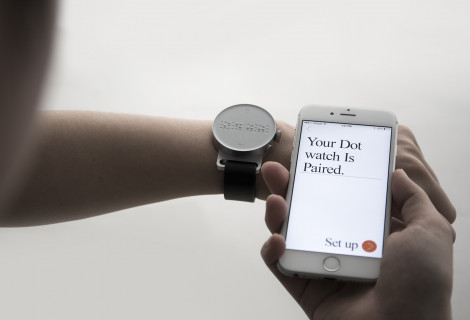Dot Watch is a sleek, minimal wristwatch with a moving braille pin display for users who are blind or visually impaired. The watch can not only communicate time and date – it can also translate text messages, notifications, the names of incoming callers, and other text from an iOS or Android device.
The Dot Watch, designed by cloudandco and manufactured by Dot Incorporation, consists of a white aluminum face with pins that move up and down to display 6-dot braille, four characters at a time, or a unique tactile code developed by the manufacturers for non-braille readers. It is physically controlled by two buttons and a scrolling dial on the display’s side edge, as well as two touch sensors located beneath the braille pins, one on the left and one on the right. Dot Watch’s moving pins are not the only method it uses to communicate with its user: it also offers feedback through vibrations and audio tones which can alert a user to items such as an incoming phone call, a new message available for reading on its display, and an alarm set by the user.
Dot Watch’s battery lasts approximately 5 to 7 days, increasing the usability of this device for users who depend on it for alarms and alerts on a daily basis. Two models, Dot Watch 1 and Dot Watch 2, have been released since the device’s initial launch in 2016, and the third model is currently in development. The price of the Dot Watch 2 ranges from about $299 to $399, making it fairly affordable when compared to models of other smartwatches such as Apple Watches.
This blog post explores the accessibility of two main features of the Dot Watch 1 and 2: the companion app and the charger.
Feature 1: Companion App

The button and dial controls on the side of Dot Watch’s face allow the user to access and select most of the Dot Watch’s settings, but the watch’s combination of simple physical controls and complex settings means that the majority of the watch’s settings must be accessed using complicated combinations of button presses. To solve this issue and extend the capabilities of the device, Dot Watch has also released a companion app for iOS and Android devices that allows all of these controls to be set using a smartphone or tablet. This app is fully accessible via screen readers such as iOS’s built-in VoiceOver.
The Dot Watch companion app enables users to customize settings such as the automatic scrolling speed for braille or tactile code displayed on the watch’s face, whether the watch is being worn on the left or right arm (which changes the orientation of the text), set alarms, check the watch’s battery status, change the watch’s language (currently available in English, Korean, German, Spanish, French, and Dot Incorporation’s tactile code), and more. It also includes a mode called Study Braille, which allows the user to send anything written on their mobile device to the Dot Watch to improve their braille skills.
The inclusion of this app aligns with the social model of disability, wherein the barriers of disability exist with society rather than the individual. The app is compatible with iOS and Android devices, two of the most popular types of smartphones and tablets, enabling users to not have to buy yet another piece of specialized equipment to use the watch – many users likely already own and use these devices to accept calls, browse the internet, and more. The language options and Study Braille mode also fit within this model, as it seeks to increase its accessibility to diverse audiences by recognizing they may come from very different language backgrounds.
It also aligns with the functional model, wherein innovative uses of technology are used to remove the barriers of disability. It increases the utility of the watch for the user – it enables them to seamlessly use the watch to not just tell time, but also communicate with others, read text, and learn new language skills.
Feature 2: Charger

The Dot Watch is charged via a unique, magnetic charger that includes indentations and braille to help users connect the watch correctly to the charger, and tactile feedback that vibrates when the watch is correctly connected to the charger and is now charging. The non-charging end of the charger has a standard USB plug that can be inserted into any USB power supply.
The Dot Watch’s charger aligns with the functional model of disability. Here, the integration of braille and vibration feedback – not just on the watch but also on the charger – increases the usability of the product for users who are blind and visually impaired. Users are able to charge this device independently and with minimal confusion. The integration of vibration feedback to inform users of when the charger is connected correctly, rather than an audio tone, increases the accessibility of this object and makes it usable by those who are also deaf or hard of hearing.
Reference List
0304, DOT WATCH, 2017. (n.d.). Cooper Hewitt, Smithsonian Design Museum. Retrieved September 12, 2022, from https://collection.cooperhewitt.org/objects/1159162247/
Belcher, J. (2015, December 17). A Smartwatch for the Visually Impaired. Smithsonian Magazine. Retrieved September 12, 2022, from https://www.smithsonianmag.com/innovation/smartwatch-visually-impaired-180957581/
Blind Assistive Technology Product. (n.d.). Dot Incorporation. Retrieved September 12, 2022, from https://www.dotincorp.com/page/31?gbn2=DotWatch
Davert, S. (2019, January). A New Kind Of Braille Watch: A Review Of The Dot Watch 2. American Foundation for the Blind. Retrieved September 12, 2022, from https://www.afb.org/aw/20/1/14990
Hagen, M. (2018, January 12). The Dot Watch Is Now Available! Closing the Gap. Retrieved September 12, 2022, from https://www.closingthegap.com/the-dot-watch-is-now-available/
Our Products. (n.d.). Dot Incorporation. Retrieved September 12, 2022, from https://buy.dotincorp.com/collections/all
